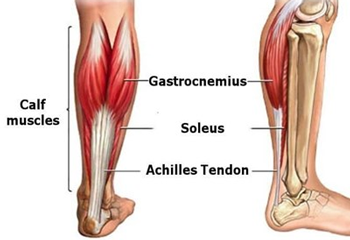Calf muscles make up the lower posterior portion of the leg.
Calf Muscles are:
2 are the calf muscles, the Gastrocnemius and Soleus.
Below is a table with Gastrocnemius and Soleus’s Origin, Insertion and Action.
| Gastrocnemius | |
| Origin | The posterior surface of the lateral and medial condyle of the femurs |
| Insertion | Calcaneus via calcaneus tendon |
| Action | Flex the knee Plantar flex the ankle |
| Soleus | |
| Origin | Soleal line; the proximal posterior surface of the tibia and posterior aspect of the head of the fibula |
| Insertion | |
| Action | Plantar flex the ankle |
So, due to their origins and insertions, we can clearly understand how the Gastrocnemius is involved in knee flexion and how the Soleus is not.

The Gastrocnemius does across the knee, as it originates from the femur itself.
On the other hand, the Soleus doesn’t cross the knee, so it doesn’t play any role at the knee level.
This aspect is so important to differentiate what of these 2 muscles are involved in the restrictive movement at the ankle, and or in calf pain.
Calf Muscles testing
Firstly the patient is lying down in a supine position (face up) doing active dorsiflexion.
Secondly, we will ask the patient to lie in a prone position (face down), and we knee bend (passively), they would go in ankle dorsiflexion again.
What happens there is when the knee is flexed passively, the Gastrocnemius is deactivated, and so the ankle dorsiflexion is happening by pulling the soleus only.
Now, 2 are the case scenarios that could happen:
- Still a limited range of motion at ankle dorsiflexion with or without pain
- A better quality of ROM with a greater angle in dorsiflexion.
In the first case, the tension muscles could still be both.
In the second case, the Gastrocnemius is clearly the muscle limiting the ROM.
For ankle ROM in dorsiflexion, we are looking for a minimum of 20° to up to 30°.
It is not all about Muscle Pain.
But can calf pain be related to something else and not just to muscle pain?
The answer is YES.
Calf muscle pain can be a RED FLEG for Deep Veins Thrombosis (DVT), especially after a flight.
DVT Symptoms:
- Sharp pain;
- Heat at the touch;
- Soreness at the touch;
- Redness on the skin.
In this case, you want to contact your GP immediately. Massages are absolute contraindications.
In conclusion, for a full calf or muscle recovery, we want to look in too some exercises.
Remedial Massage, Myotherapy, and Thai Massage are great ways to reduce pain and manage symptoms, but exercises are essential actually to heal a muscle.
Indeed, when we talked about plantar fasciitis, those exercises are something that we can look at for calf strengthening.